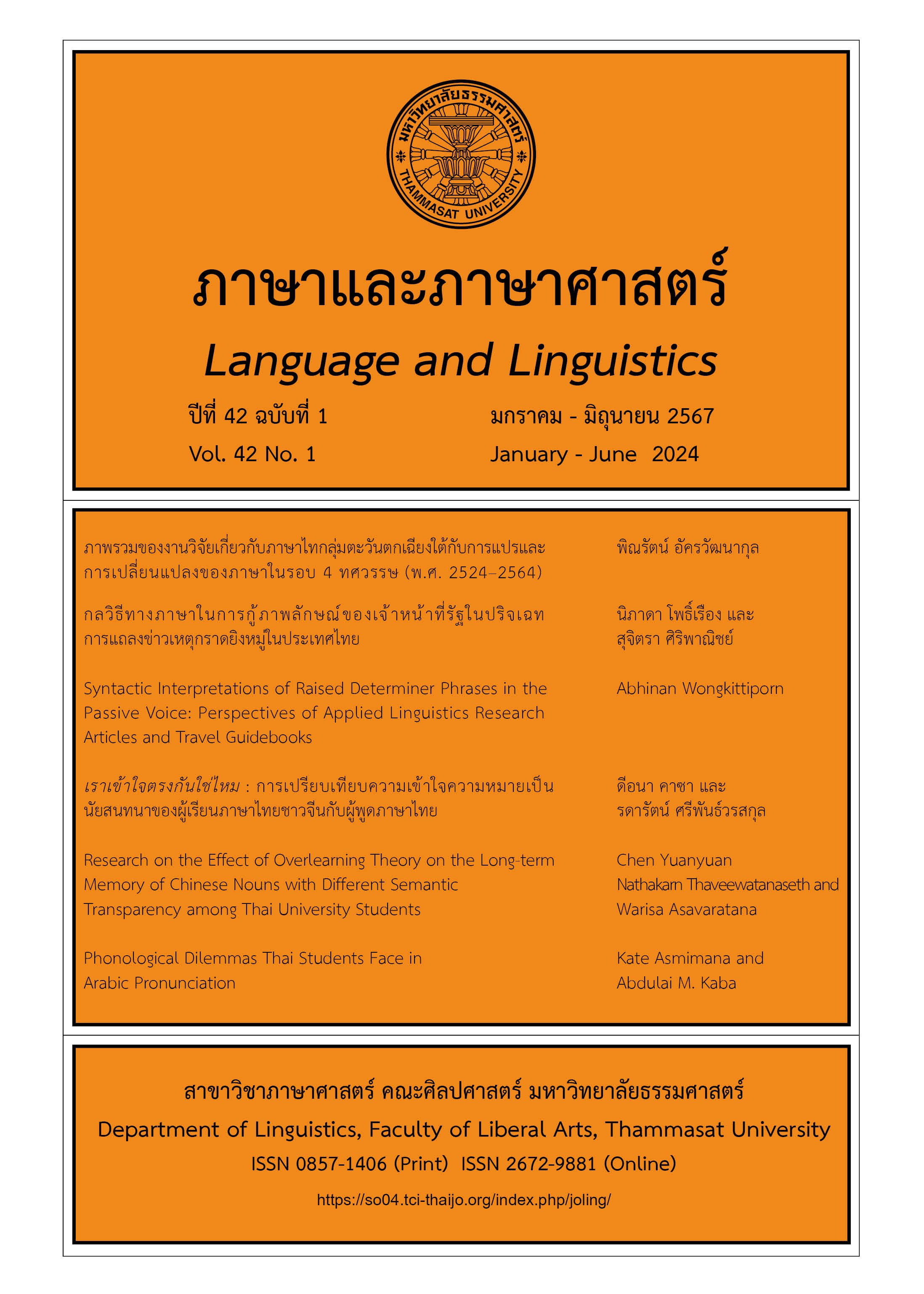Syntactic Interpretations of Raised Determiner Phrases in the Passive Voice: Perspectives of Applied Linguistics Research Articles and Travel Guidebooks
Main Article Content
Abstract
This study investigates syntactic interpretations of the raised determiner phrase (DP) in passive voice via applied linguistics research articles and travel guidebooks as written in English. The sources of data in this study were gathered from English applied linguistics research journals as indexed in the SCOPUS database (scopus.com) and the travel guidebooks were guides from the countries of France (McGill, 2021) and Spain (Keshan & Sanwalia, 2022) due to their highest numbers of tourist visits. A total number of approximately 300,000 words is made up of an entire 39 tokens, referring to sentences. The current study follows Radford’s (2009) framework to analyze the data. The results of the raised DP in passive voice in applied linguistics research articles show the same DP between given and new information at 62.50 percent due to the principle of consistency in academic writing. The results of travel guidebooks are in contrast in that the given information of the raised DP in passive voice is mostly used with the syntactic interpretation of the replacement by pronoun at 73.91 because of gender identification. The pronouns he or she, referring to the proper noun, are used as the given information. It is expected that the results in this study will be useful for learners of English as a Foreign Language (EFL) in order to apply the raised DP in passive voice accurately.
Article Details

This work is licensed under a Creative Commons Attribution-NonCommercial-NoDerivatives 4.0 International License.
บทความทุกบทความเป็นลิขสิทธิ์ของภาษาและภาษาศาสตร์
References
Ädel, A. (2023). Adopting a ‘move’ rather than a marker approach to metadiscourse: A taxonomy for spoken student presentation. Journal of English for Specific Purposes, 69, 4-18.
Deroey, K. L. B. (2023). English medium instruction lectures training programmes: Content, delivery, way forward. Journal of English for Academic Purposes, 62, Article 101223.
Halliday, M. A. K., & Hasan, R. (1976). Cohesion in English. Longman.
Jaworska, S. (2023). But then something happened: A critical multimodal genre analysis of corporate image repair videos. Journal of English for Specific Purposes, 69, 95-108.
Keshan, N., & Sanwalia, A. (2022). Spain. Penguin Random House.
Lindenberg, D. (2023). Modes and intersemiotic cohesion in the student presentations performed online: An SF-informed multimodal discourse analysis. English for Specific Purposes, 69, 67-79.
Luzón, M. J. (2023). Multimodal practice of research groups in Twitter: An analysis of stance and engagement. English for Specific Purposes, 70, 17-32.
McGill, A. (2021). France. Penguin Random House.
McGrath, D., & Liardét, C. (2023). Grammatical metaphor across disciplines: Variation, frequency, and dispersion. English for Specific Purposes, 69, 33-47.
Nguyen, H. (2023). Interactional sociolinguistics as a multi-pronged approach to office hour rapport management. Journal of English for Academic Purposes, 62, Article 101213.
O’Neill, D.K. (2005). Talking about “new” information: The given/new distinction and children’s developing theory of mind. In J. W. Astington & J. A. Baird (Eds.), Why language matter for theory of mind (pp. 84–105). Oxford University Press.
Picavet, F., Henderson, A., & de Vries, E. (2023). Storytelling in L2 English-medium engineering lectures: A typology. Journal of English for Academic Purposes, 62, Article 101214.
Radford, A. (2009). An introduction of English sentence structure. Cambridge University Press.
Sawaki, T. (2023). High use of direct questions and relative absence of promotional intention in Japanese peer-reviewed research article introductions compared to their English counterparts. Journal of English for Specific Purposes, 69, 19-32.
Sun, Y. (2023). Increasing critical language awareness through translingual practices in academic writing. Journal of English for Academic Purposes, 62, Article 101229.
Wharton, E. (2022). The age of innocence. Chiltern.
Wongkittiporn, A. (2022a). Semantic interpretations of passive constructions in business news articles. Journal of Language, Religion and Culture, 11(2), 1-29.
Wongkittiporn, A. (2022b). Pragmatic interpretations of raised arguments in English Novels. Journal of Liberal Arts, Prince of Songkla University, 14(1), 27-54.
Yang, M. (2023) Supervisory feedback, reflection and academic discourse socialization: Insight from L2 doctoral students’ papers writing experience. Journal of English for Academic Purposes, 62, Article 101215.
Yoon, H. J., & Tabari, M. (2023). Authorial voice in source-based and opinion-based argumentative writing: Patterns of voice across task and proficiency levels. Journal of English for Academic Purposes, 62, Article 101228.


